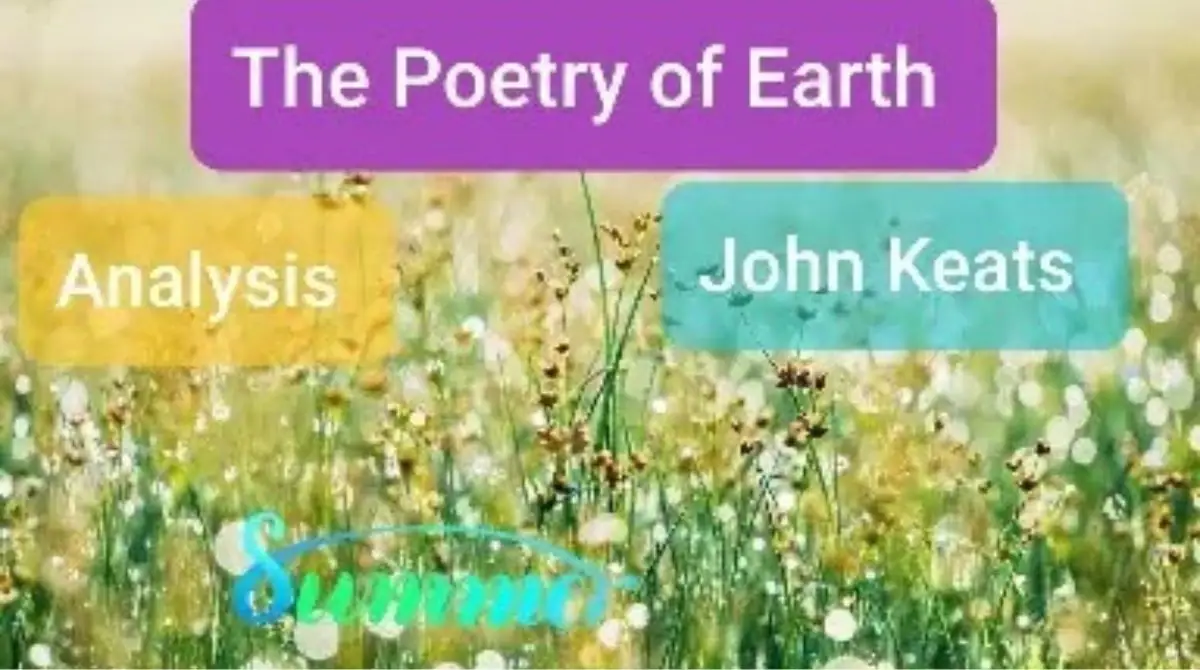Descriptive Questions Answers Analysis of the Poem The Poetry of Earth by John Keats
Today we are going to decrustation of the poem “The Poetry of Earth” and will go to some important questions answers of the poem the Poetry of Earth
Click on the Video to have the analysis of the poem. Let’s start……
Analysis of the poem The Poetry of Earth
Click on the play button to get the Analysis of the Poem The Poetry of Earth.
Important Questions Answers from The Poetry of Earth
(1) Explain the title of the poem, “The Poetry of Earth”.
Ans:- John Keats’ sonnet “The Poetry of Earth” is about the celebration. It is the celebration of the continuity of the music of earth. This theme is aptly presented through the title of the poem. The title clearly brings out the poet’s concept that earth has music of its own.
This is natural and comes from different natural sounds like – sounds of birds, insects, beasts etc. These natural sounds are the voices of nature with which nature communicates with us. The poet in this poem has established that the music of earth can always be found alive even in the two extreme of weather like summer and winter seasons.
When the summer sun is too hot, then the singing birds find it difficult to keep up their notes. Then the grasshopper takes the lead in summer luxury and continues singing. This song may also be echoed in the shrill of crickets hovering around fireplace in a cold, desolate winter evening. The warmth coming from the fireplace mingles with the warm tones of the cricket who tries to keep the music of earth alive.
Thus the grasshopper and the cricket provide us joy as well as the hope of life through their songs. These songs are poetry of earth, the poetry that never ceases to be, even during the extreme circumstances. Though the original title of the poem is “On the Grasshopper and Cricket” but the title “The Poetry of Earth” which itself the first line of the sonnet aptly brings out the theme of the sonnet. So, the title is justified.
(2) Identify the sounds of earth in the poem, “The Poetry of Earth” and how does the poet establish the continuity of the music through these sounds.Or, How does Keats present the two opposite sides of seasons to establish the continuity of the songs of the earth?
Ans:- To show the eternal existence of the poetry that is the music of earth, the poet in this poem places two extreme seasons of weather like summer and winter side by side as two parameters of extremity around which the song of nature continues to thrive.
In the summer season, when the sun becomes too hot, then the sweet little birds that form so much of the song of earth, have to hide themselves under the cooling shades. It is then the song of earth emerges from the little insect grasshopper. Its voice runs throughout the freshly mown meadows untiringly.
In the second part of the poem, the poet begins with the same declaration that poetry of earth is forever, endless. Even in an extreme cold winter evening, when one is numbed by cold, only one voice is heard that gives the warmth of life and that is the cricket. To a drowsy fellow, the song of the cricket around the stove and the grasshopper in grassy hills can not be separately identified. Both of them have the same uniformity of the song of earth which is never dead.
(3) “….. a voice will run / From hedge to hedge……” –What is the voice referred to here? When will this run and how?
Or, “….. he has never done with his delights.” — Who is ‘he’ referred to here? How does he delight? What does he finally do?
Ans:- The ‘voice’ referred to here is the voice of grasshopper hovering among the hedges.
In the poem, “The Poetry of Earth” the poet J. Keats joyously celebrates the music of earth in its different natural sounds like sounds of birds, insects, beasts etc. The poet brings out the declaration that the poetry of earth is never dead.
Even in the scorching heat of summer, when the sweet, little birds being exhausted with heat hide themselves under the cooling shades, then a voice runs throughout the hedges. The grasshopper does not cease its song in summer luxury. His delights never come to an end. When it gets tired, it takes rest ‘beneath some pleasant weed’ to refresh itself to provide the poetry of earth.
Here the grasshopper is the symbol of hope. The grasshopper takes the lead to keep the music of earth alive, even when the others can not. It provides everyone with hope that no matter how hard the situation is, there is always a way to overcome them. Thus, it is the hope that constitutes in the voice of grasshopper hovering among the hedges.
You May Like To Read More:
